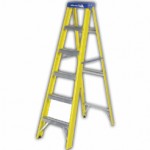
An extremely important thing to consider prior to using any ladder is checking for any damage. Always inspect your ladder before setting the ladder up and after you have used it. Louisville ladder’s C.L.I.M.B. Academy lists the following suggestions on how to go about your inspection.
1.Begin at the bottom, making sure the feet are not broken or malfunctioning and that the slip-resistant pads are secure.
2.Inspect the ladder for cracks, bends, and splits on side rails, rungs, and steps.
3.Check all rung/step-to-side rail connections, as well as hardware, fittings and accessories. Make sure both rung locks are in working order.
4.Test the rope and pulley for smooth operation. Replace the rope if frayed or partially cut.
5.All pivotal connections and the rung-locks should be well-lubricated.
6.All bolts and rivets should be secure. Never use a ladder if any bolts or rivets are missing or if the joints between the steps (or rungs) and the side rails are not tight.
7.Make sure the ladder (particularly the steps and rungs) is free of foreign materials such as oil and grease.
8.If you’re using a stepladder, make sure the spreader braces are not bent, are secure and working properly.
They further say that you should use a ladder inspection chart as a guide for evaluating the safety of a ladder and never use an unsafe ladder. If you find any faults as listed above DO NOT USE THE LADDER! Mark the ladder as unsafe!
The folks at Louisville Ladder have a great short training program available on-line that briefly explains the ins and outs of ladder safety called C.L.I.M.B. Academy. It’s very useful and am proud to say that several of us have successfully completed the C.L.I.M.B. Academy Training Program. Go on… Educate yourself.
